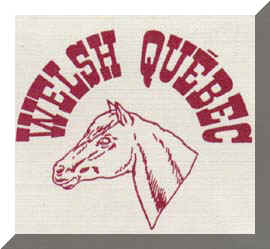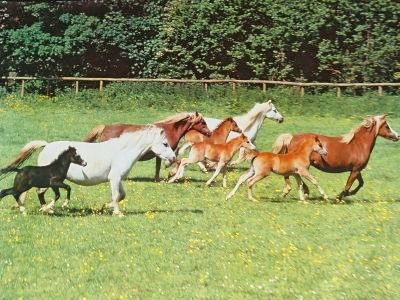 À
propos de la race the
english version follow
À
propos de la race the
english version follow À
propos de la race the
english version follow
À
propos de la race the
english version follow
Le Welsh, ou le Gallois, est originaire des vallées et des collines du pays de Galles, en Angleterre. Ils comptent parmi leur ancêtres les poneys celtes qui occupaient cette région avant eux. Lors de la conquête romaine Jules César, lui-même, tomba sous leur charme. Les poneys Welsh d'alors furent donc très appréciés des Romains qui décidèrent d'améliorer la race par différents croisements avec des chevaux orientaux, pour leur apparence, et des chevaux des montagnes, pour leur robustesse.
 C'est
au XIIe siècle que les poneys Welsh Cob (section C) et les Welsh Cob
(section D) firent leur apparitions suite aux croisements entre des poneys Welsh
Mountain (section A) et des chevaux espagnols.
C'est
au XIIe siècle que les poneys Welsh Cob (section C) et les Welsh Cob
(section D) firent leur apparitions suite aux croisements entre des poneys Welsh
Mountain (section A) et des chevaux espagnols.
Au XVIe siècle, par caprice du roi Henri VIII, on avait ordre d'abattre tout cheval mesurant moins qu'un mètre quarante (1,40 m). Ces mesures ont menacé l'existence des Welsh, heureusement plusieurs petits chevaux ne furent pas massacrés, s'étant cachés dans les montagnes.
Des années plus tard, des étalons, arabes et pur-sang en majorité, furent libérés dans ces montagnes. Le poney Welsh (section B) fit son apparition suite à ces croisements. La légende veut qu'un étalon pur-sang du nom de Merlin, soit le père des Welsh que l'on connait aujourd'hui, en effet durant longtemps les habitants du pays de Galles surnomaient les Welsh, des Merlins, en souvenir de leur ancêtre.
Parce qu'il a un excellent bagage génétique le Welsh est, lors de croisement, un améliorateur de race. Du sang Welsh coule dans les veines du Cob, du Hunter, du Riding Pony, du poney de polo et même dans celles du pur-sang contemporain. Il est à noter que les poulains insu de croisement avec le Welsh héritent très souvent de son ossature exceptionnelle et de son étonnante robustesse.
Vous pouvez lire un article sur le Welsh, écrit par notre secrétaire, dans la revue Equi-Libre de Québec à cheval, volume 23, no 1, été 2004, p. 48 et ss
Section A is the Welsh Mountain Pony and Section B is the Welsh Pony. Section A's are hardy, spirited and pony-like and do not exceed 12 h.h. (121.9 cms). Section B's are similar, but larger — up to 13.2 h.h. (137.2 cms) — and with more riding pony qualities. Section C is the Welsh Pony of Cob Type and Section D is the Welsh Cob. The main difference is size: Section C's do not exceed 13.2 h.h. (137.2 cms) while Section D's are larger.
Section A: The Welsh Mountain Pony
Bred in the mountains and wild regions of Wales for many generations, their acknowledged beauty does not mean they are merely a 'pretty toy' — centuries of 'survival of the fittest' has ensured the sound constitution, iron hard limbs and great intelligence which combined with the legendary Welsh temperament, makes the ideal child's pony of today. They can be seen ridden and driven all over the world — equally at home in the cold of Canada and Sweden or the heat of Africa and Australia.
The head of the Mountain Pony should be small, with neat pointed ears, big bold eyes and a wide forehead. The jaw should be clean cut, tapering to a small muzzle; the silhouette may be concave or 'dished' but never convex or too straight. The neck should be of good length and well carried with shoulders sloping back to a clearly defined wither. The limbs must be set square with good flat bone and round dense hooves. The tail set high and gaily carried.
Action must be straight both in front and behind, quick and free with hocks well flexed.
The height should not exceed 12 h.h. (121.9 cms).
Detailed Description
General Character
Hardy, spirited and pony-like
Colour
Any colour, except piebald and skewbald
Head
Small, clean-cut, well set on and tapering to the muzzle
Eyes
Bold
Ears
Well-placed, small and pointed, well up on the head, proportionately close
Nostrils
Prominent and open
Jaws and Throat
Clean and finely-cut, with ample room at the angle of the jaw
Neck
Lengthy, well-carried and moderately lean in the case of mares, but inclined to
be cresty in the case of mature stallions
Shoulders
Long and sloping well back. Withers moderately fine, but not "knifey".
The humerus upright so that the foreleg is not set in under the body
Forelegs
Set square and true, and not tied in at the elbows. Long, strong forearm, well
developed knee, short flat bone below knee, pasterns of proportionate slope and
length, feet well-shaped and round, hoofs dense.
Back and Loins
Muscular, strong and well coupled
Girth
Deep
Ribs
Well sprung
Hind Quarters
Hocks to be large, flat and clean with points prominent, to turn neither inwards
nor outwards. The hind legs not to be too bent. The hock not to be set behind a
line from the point of the quarter to the fetlock joint. Pasterns of
proportionate slope and length. Feet well-shaped, hoofs dense.
Action
Quick, free and straight from the shoulder, well away in front. Hocks well
flexed with straight and powerful leverage well under the body.
The general description of the Welsh Mountain Pony can be applied to the Welsh Pony, with greater emphasis being placed on riding pony qualities whilst retaining the true Welsh quality with substance.
For generations these ponies were the hill farmers' main means of transport, herding sheep and wild ponies over rough and mountainous country. They had to be hardy, balanced and fast to survive, which ensured that only the best were bred from. These qualities, combined with a natural jumping ability, and the temperament of their Welsh Mountain Pony forebears make the Welsh Pony second to none in whatever field his young rider may choose. Today they hold their own among our top class riding ponies both in performance competitions and in the show ring.
The height should not exceed 13.2 h.h. (137.2 cms).
Detailed Description
The general description of ponies in Section A of the Stud Book is applicable to those in Section B, but more particularly the Section B pony shall be described as a riding pony, with quality, riding action, adequate bone and substance, hardiness and constitution and with pony character.
Section C: The Welsh Pony of Cob Type
The Welsh Pony of Cob Type, Section C, is the stronger counterpart of the Welsh Pony, but with Cob blood.
Their true worth as a dual purpose animal has been fully realised in recent years, and their numbers have increased accordingly.
Active, surefooted and hardy, they are ideal for so many purposes both for adults and children.
Like all the Welsh Breeds they are natural jumpers and they also excel in harness — there are in fact few things that they cannot be used for.
The height should not exceed 13.2 h.h. (137.2 cms).
Detailed Description
General Character
Strong, hardy and active, with pony character and as much substance as possible
Colour
Any colour, except piebald and skewbald
Head
Full of quality and pony character. A coarse head and Roman nose are most
objectionable
Eyes
Bold, prominent and set widely apart
Ears
Neat and well set
Neck
Lengthy and well carried. Moderately lean in the case of mares, but inclined to
be cresty in the case of mature stallions
Shoulders
Strong but well laid back
Forelegs
Set square and not tied in at the elbows. Long, strong forearms. Knees well
developed with an abundance of bone below them. Pasterns of proportionate slope
and length. Feet well-shaped. Hoofs dense. When in the rough, a moderate
quantity of silky feather is not objected to but coarse, wiry hair is a definite
objection.
Middlepiece
Back and loins, muscular, strong and well-coupled. Deep through the heart and
well-ribbed up.
Hind Quarters
Lengthy and strong. Ragged or drooping quarters are objectionable. Tail well-set
on.
Hind Legs
Second thighs, strong and muscular. Hocks, large, flat and clean, with points
prominent, turning neither inward nor outwards. The hind legs must not be too
bent and the hock not set behind a line falling from the point of the quarter to
the fetlock joint. Pasterns of proportionate slope and length. Feet well-shaped.
Hoofs dense.
Action
Free, true and forcible. The knee should be bent and the whole foreleg should be
extended straight from the shoulder and as far forward as possible in the trot.
Hocks flexed under the body with straight and powerful leverage
Aptly described as "the best ride and drive animal in the World", the Welsh Cob has been evolved throughout many centuries for his courage, tractability and powers of endurance.
The general character is the embodiment of strength, hardiness and agility. the head shows great quality with Pony character: bold prominent eyes, a broad forehead and neat, well set ears. The body must be deep, on strong limbs with good "hard wearing" joints and an abundance of flat bone. Action must be straight, free and forceful, the knees should be bent and then the whole foreleg extended from the shoulders as far as possible in all paces, with the hocks well flexed, producing powerful leverage.
The Welsh Cob is a good hunter and a most competent performer in all competitive sports. In recent years they have had great success in the international driving world. Their abilities in all spheres are now fully recognised throughout the world.
The height should exceed 13.2 h.h. (137 cms): no upper limit.
Detailed Description
General Character
Strong, hardy and active, with pony character and as much substance as possible
Colour
Any colour, except piebald and skewbald
Head
Full of quality and pony character. A coarse head and Roman nose are most
objectionable
Eyes
Bold, prominent and set widely apart
Ears
Neat and well set
Neck
Lengthy and well carried. Moderately lean in the case of mares, but inclined to
be cresty in the case of mature stallions
Shoulders
Strong but well laid back
Forelegs
Set square and not tied in at the elbows. Long, strong forearms. Knees well
developed with an abundance of bone below them. Pasterns of proportionate slope
and length. Feet well-shaped. Hoofs dense. When in the rough, a moderate
quantity of silky feather is not objected to but coarse, wiry hair is a definite
objection.
Middlepiece
Back and loins, muscular, strong and well-coupled. Deep through the heart and
well-ribbed up.
Hind Quarters
Lengthy and strong. Ragged or drooping quarters are objectionable. Tail well-set
on.
Hind Legs
Second thighs, strong and muscular. Hocks, large, flat and clean, with points
prominent, turning neither inward nor outwards. The hind legs must not be too
bent and the hock not set behind a line falling from the point of the quarter to
the fetlock joint. Pasterns of proportionate slope and length. Feet well-shaped.
Hoofs dense.
Action
Free, true and forcible. The knee should be bent and the whole foreleg should be
extended straight from the shoulder and as far forward as possible in the trot.
Hocks flexed under the body with straight and powerful leverage
